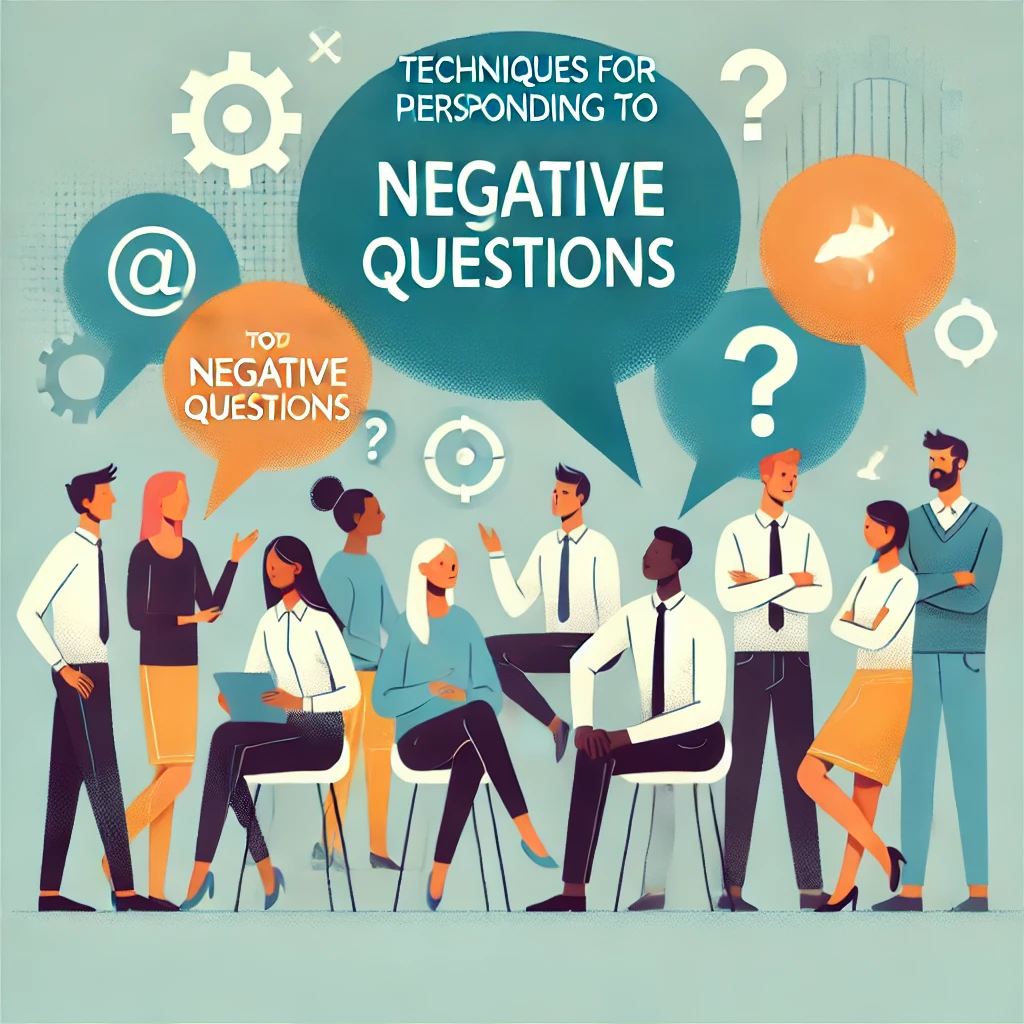In life, it’s almost inevitable that we’ll face difficult or negative questions—questions that feel accusatory, critical, or even confrontational. Whether these questions arise at work, during social interactions, or within personal relationships, they can catch us off guard and sometimes make us feel defensive or frustrated. Yet, how we respond to these questions can significantly influence the outcome of the conversation and even our relationships with others.
This guide will walk you through practical strategies for responding to negative questions, helping you remain calm and composed, even in uncomfortable situations. You’ll learn techniques for reframing negative assumptions, using empathy to diffuse defensiveness, and even setting boundaries when questions cross the line. By practicing these methods, you’ll build confidence and resilience, making difficult conversations less daunting and more constructive.
Understanding Negative Questions
Negative questions are inquiries that carry an underlying tone of criticism, doubt, or accusation, often leaving the recipient feeling defensive or on edge. These questions may be intentional or unintentional, yet they share a tendency to challenge or undermine the person being asked.
For example, questions like “Why didn’t you finish this task on time?” or “Do you really think that’s a good idea?” often imply judgment and can feel confrontational. People may ask such questions out of frustration, dissatisfaction, or simply to seek clarification on an issue that concerns them. It’s common to encounter these types of questions in workplaces, family discussions, and even on social media, where rapid-fire interactions can escalate quickly.
Understanding the underlying intent behind negative questions is the first step toward responding effectively. By recognizing whether the question is a call for more information, an expression of frustration, or a subtle critique, you can tailor your response to address the core concern without letting emotions dictate the interaction.
What Are Negative Questions?
Negative questions are questions framed in a way that often implies criticism, doubt, or skepticism. Unlike neutral questions, which simply seek information, negative questions carry an underlying tone that can make the recipient feel judged or put on the spot. These questions typically use negative language or phrasing that suggests something is wrong or needs defending, such as “Why haven’t you completed this task yet?” or “Don’t you think that was a mistake?” By their nature, these questions can feel accusatory, even if that’s not the intent, as they often push the recipient to defend their actions or opinions.
Negative questions can surface in a variety of contexts—from workplaces and personal relationships to online forums—and can subtly shift the balance of a conversation, placing the focus on what’s perceived as a problem or flaw. Understanding the framing and tone of these questions is important for responding effectively, as it allows you to recognize the hidden assumptions and address them without becoming defensive.
Why People Ask Negative Questions
People ask negative questions for various reasons, often depending on their emotions, intentions, and context. In some cases, negative questions stem from frustration or dissatisfaction, where the questioner may feel let down or misunderstood and expresses this through a critical or confrontational tone. For example, in a workplace setting, a manager might ask, “Why isn’t this done yet?” when they’re under pressure to meet a deadline.
Negative questions can also reflect a desire for clarification, especially when there’s confusion or doubt about a situation; someone might ask, “Don’t you think that approach is risky?” to address concerns or encourage further explanation. Additionally, some people use negative questions as a way of testing opinions or challenging ideas, pushing the respondent to consider potential flaws or alternative perspectives.

Common Reactions to Negative Questions
When faced with negative questions, many people have common reactions, often emotional and immediate, because such questions can feel accusatory or judgmental. The most typical reactions include defensiveness, where the person feels compelled to justify or defend their actions or opinions, which can inadvertently escalate the tension.
Another common response is irritation or anger, as negative questions can feel like an attack on one’s competence or character, making it tempting to respond with sarcasm or hostility. Some people may also feel hurt or self-doubt, especially if the question touches on a sensitive area, leading them to withdraw or question their abilities. In professional settings, negative questions can sometimes trigger anxiety, as they may be perceived as signals of disapproval or criticism from superiors.
While these reactions are natural, they can create a cycle of negativity, where both the questioner and responder become more focused on defending themselves rather than resolving the issue. By becoming aware of these common reactions, individuals can work toward managing their emotions and responding thoughtfully, keeping the conversation productive rather than reactive.
Key Techniques for Responding to Negative Questions
Responding to negative questions can be tricky, but using simple techniques can help you stay calm and keep things positive. Here’s how to handle tough questions in a way that leaves everyone feeling understood and respected.
- Stay Calm and Take a Pause
When you get a negative question, it’s natural to feel a bit defensive or even upset. Instead of answering right away, take a moment to breathe and think. A quick pause helps you gather your thoughts and keeps you from reacting emotionally. This short break shows the person asking that you’re really considering their question, which can make them feel heard and valued.
- Acknowledge the Question Without Reacting Emotionally
Acknowledging the question shows that you’re listening without instantly agreeing or disagreeing. Simple phrases like, “I understand what you’re saying” or “I see where you’re coming from” let the person know you’re open to their point of view. This can calm the situation, as they feel you’re not dismissing them right away. Acknowledging doesn’t mean you agree; it just means you’re willing to listen.
- Ask for Clarification if Needed
Negative questions are often unclear or based on assumptions. If you don’t fully understand the question, ask for clarification. For instance, “Could you tell me more about what you mean?” or “Can you explain your concern further?” This way, you’re addressing the real issue rather than guessing or assuming what they meant.
- Use Empathy to Show Understanding
Showing empathy means trying to understand and acknowledge the other person’s feelings, even if you don’t fully agree. Responses like, “I understand this might be frustrating for you” or “I see why you might feel that way” can go a long way in easing tension. It shows the other person that you’re not just focused on yourself—you also care about how they feel, which often helps calm things down.
- Reframe Negative Assumptions Positively
Sometimes you can rephrase or “reframe” the question to make it more positive. If someone asks, “Why didn’t you do this better?” you could reply with something like, “I’m always looking to improve—do you have specific suggestions?” By focusing on the solution or looking for ways to improve, you shift the conversation away from blame and make it more constructive.
- Set Boundaries If the Question Goes Too Far
Some questions can cross a line and make you feel uncomfortable or disrespected. In these cases, it’s okay to set boundaries. You can say things like, “I’d appreciate if we keep things respectful,” or “Let’s focus on the main issue.” This lets the person know that you’re not okay with negativity or disrespect, but still open to discussing the main point. Setting boundaries helps you protect yourself and steer the conversation back to a healthy place.
Responding to Negative Questions in Different Settings
Responding to negative questions varies depending on the setting, as each requires a slightly different approach to stay professional, respectful, and composed.
- Workplace
In professional settings, responding diplomatically is essential to maintain a productive atmosphere. Use respectful language, stay calm, and focus on solutions, which shows you’re committed to teamwork and open communication. - Social Media and Online
Negative questions online can escalate quickly, so it’s best to stay polite and direct. Acknowledge valid points, keep responses concise, and avoid engaging if it becomes unproductive. This approach prevents unnecessary conflicts and maintains a positive online presence. - Personal Relationships
Negative questions in personal interactions can be emotionally charged. Here, empathy and understanding are crucial. Listen actively, acknowledge the other person’s feelings, and respond gently to maintain trust and avoid escalating the situation. This approach shows you care while addressing the issue constructively.
Conclusion
Handling negative questions effectively is a valuable skill that can improve your relationships and boost your confidence. By staying calm, showing empathy, asking for clarification, and setting healthy boundaries, you can respond to challenging questions in ways that foster understanding rather than conflict. Practicing these techniques not only helps you navigate tough conversations but also builds your reputation as a thoughtful, composed communicator in both personal and professional settings. With time and patience, you’ll feel more in control during difficult interactions, turning what could be uncomfortable moments into opportunities for growth and connection
Frequent Asking Questions (FAQs)
- What should I do if a question feels like a personal attack?
If a question feels like a personal attack, take a deep breath and try to respond calmly. Use phrases like, “I’d appreciate if we keep things respectful,” or redirect the conversation to focus on constructive points. If necessary, politely set boundaries to maintain a positive atmosphere. - How can I stay calm when I feel defensive?
Pausing for a moment before responding can help you control defensive feelings. Take a deep breath, count to five, or briefly consider your response. This allows you to respond thoughtfully rather than reactively, keeping the conversation productive. - What’s the best way to handle negative questions in the workplace?
In the workplace, remain respectful and professional. Address the question’s underlying concern and focus on solutions. Show that you value teamwork and constructive feedback, which reflects positively on your communication skills.
Found this helpful? Don’t miss out on our other great articles!



